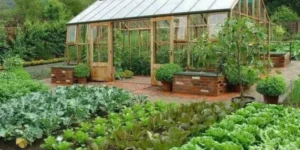Sloping terrain often presents challenges for gardeners, but with careful planning and construction, raised garden beds can transform an inclined space into a productive and visually appealing oasis.
This guide will explore the various aspects of creating successful raised garden beds on a slope, from initial planning to ongoing maintenance. Discover how to overcome common obstacles, optimize your garden’s layout, and enjoy the rewards of cultivating on uneven ground.
Planning Your raised garden bed slope

Assessing the Slope
- Determining the slope’s angle and length
- Identifying potential challenges and opportunities
- Considering soil type and drainage
Determining the Best Orientation
- Maximizing sunlight exposure
- Minimizing erosion
- Aligning with the natural slope for efficient water runoff
Choosing the Right Materials
- Selecting materials suitable for the slope (wood, stone, concrete)
- Considering durability and longevity
- Budgeting for materials
Determining Bed Size and Shape
- Optimizing space utilization on the slope
- Creating functional and aesthetically pleasing designs
- Considering the types of plants you want to grow
Construction Techniques
Creating Level Platforms on a Slope
- Assessing the slope for suitable areas to create flat platforms
- Excavating and leveling the ground
- Building retaining walls or using natural barriers to contain soil
- Considerations for soil stability and erosion prevention
Building Terraced Garden Beds
- Designing steps or terraces to accommodate the slope
- Constructing retaining walls for each level
- Ensuring proper drainage between terraces
- Creating pathways or steps for access
Constructing Stepped Garden Beds
- Building individual raised beds in a stair-like pattern
- Using varying heights for each bed
- Considering the overall aesthetic and functionality
- Addressing drainage and soil retention
Utilizing Retaining Walls for Support
- Choosing suitable materials for retaining walls (stone, brick, concrete, wood)
- Ensuring proper installation and stability
- Considering the height and weight of the retaining wall
- Integrating the retaining wall into the overall garden design
Drainage Considerations
- Installing drainage pipes or gravel layers
- Creating overflow channels to prevent waterlogging
- Balancing water retention and drainage needs
- Protecting the soil from erosion
Planting and Maintenance
Soil Preparation for Sloping Beds
Creating a healthy foundation for your plants is crucial, especially on a slope. Start by amending the soil with organic matter like compost or aged manure to improve drainage and nutrient content. For heavy clay soil, incorporate sand or other drainage materials to enhance water percolation. Consider creating raised planting areas within the bed using additional soil or mounding techniques. This helps improve drainage and creates microclimates for specific plants.
Plant Selection for Sloping Conditions
Choosing the right plants is essential for success on a slope. Opt for plants that thrive in well-drained soil, as slopes tend to dry out quickly. Plants with cascading or trailing growth habits can add visual interest and help control erosion on terraced beds. Consider root depth; deep-rooted plants stabilize the slope and prevent erosion.
Watering and Fertilization Techniques
Watering frequency depends on slope steepness, sun exposure, and soil type. Beds on steeper slopes or in full sun dry out faster. Use slow-release fertilizers to minimize nutrient runoff. Apply mulch to retain moisture, suppress weeds, and regulate soil temperature.
Erosion Control Measures
Protecting your slope from erosion is vital. Utilize groundcovers like creeping thyme or sedum to cover the soil. Install edging materials like stones or bricks around the bed’s perimeter to contain soil. Consider erosion control fabric on steeper slopes.
Pest and Disease Management
Slopes can create areas of higher moisture, increasing pest and disease risks. Monitor plants frequently, especially after rain or high humidity. Implement organic pest control methods like insecticidal soap or neem oil. Choose pest-resistant plant varieties to reduce pesticide needs.
By following these guidelines, you can create a thriving and sustainable garden on your sloping terrain.
Additional Considerations
While constructing and maintaining a raised garden bed on a slope presents unique challenges, there are also opportunities to enhance both functionality and aesthetics.
- Aesthetic Appeal of Sloping Garden Beds: Consider incorporating decorative elements like stone pathways, ornamental grasses, or flowering vines to enhance the visual appeal of your sloping garden.
- Incorporating Paths and Walkways: Creating paths or steps between raised garden beds can improve accessibility and add visual interest.
- Using Raised Beds on a Slope for Different Crops: Explore the potential of growing different crops on different levels of your slope. For example, you might grow taller plants on the upper levels and lower-growing plants on the lower levels.
- Water Harvesting: Consider installing water-harvesting systems to collect and utilize rainwater, especially in areas with limited water resources.
- Wildlife Considerations: Create habitats for beneficial insects and pollinators by incorporating native plants and providing water sources.
By carefully considering these additional factors, you can create a thriving and visually appealing garden on your sloping terrain.
Conclusion
Creating a thriving garden on a slope is entirely achievable with the right approach. Raised garden beds offer a versatile solution to harness the potential of inclined land.
By carefully considering factors such as slope assessment, material selection, construction techniques, and ongoing maintenance, you can transform a challenging space into a productive and visually appealing garden. Embrace the unique opportunities that a sloping garden presents, and enjoy the fruits of your labor.
Remember, with patience and creativity, you can overcome any gardening obstacle.v





